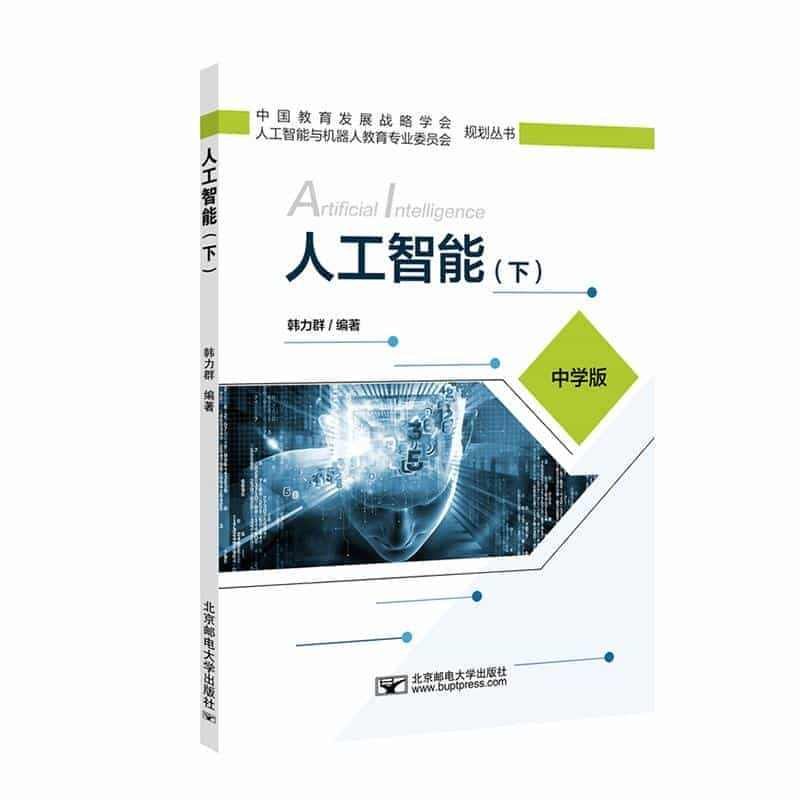分类
商品
- 商品
- 店铺
- 资讯

本书首先介绍人工智能机器人的定义、历史和体系结构,然后全面系统地阐述人工智能机器人在传感、感知、运动、规划、导航、学习、交互等方面的基础理论和关键技术。全书共分为五部分。**部分共5章,定义了什么是智能机器人,介绍了人工智能机器人简史,并讨论了自动化与自治、软件体系结构和遥操作;*二部分共6章,针对机器人的反应(行为)层智能展开讨论,分别对应机器人行为、感知与行为、行为协调、运动学、传感器与感知,以及距离感知等方面的内容;第三部分共5章,详细讨论机器人的慎思层智能,包括慎思层的内涵、导航、路径和动作规划、定位、建图与探索,以及机器学习等内容;第四部分共2章,讨论机器人的交互层智能,包括多机器人系统和人-机器人交互;第五部分共2章,分别介绍自治系统的设计与评估方法,以及与机器人相关的伦理问题。

I Framework for Thinking About AI and Robotics
1 What Are Intelligent Robots?
1.1 Overview
1.2 Definition: What Is an Intelligent Robot?
1.3 What Are the Components of a Robot?
1.4 Three Modalities: What Are the Kinds of Robots?
1.5 Motivation: Why Robots?
1.6 Seven Areas of AI: Why Intelligence?
1.7 Summary
1.8 Exercises
1.9 End Notes
2 A Brief History of AI Robotics
2.1 Overview
2.2 Robots as Tools, Agents, or Joint Cognitive Systems
2.3 World War II and the Nuclear Industry
2.4 Industrial Manipulators
2.5 Mobile Robots
2.6 Drones
2.7 The Move to Joint Cognitive Systems
2.8 Summary
2.9 Exercises
2.10 End Notes
3 Automation and Autonomy
3.1 Overview
3.2 The Four Sliders of Autonomous Capabilities
3.2.1 Plans: Generation versus Execution
3.2.2 Actions: Deterministic versus Non-deterministic
3.2.3 Models: Open- versus Closed-World
3.2.4 Knowledge Representation: Symbols versus Signals
3.3 Bounded Rationality
3.4 Impact of Automation and Autonomy
3.5 Impact on Programming Style
3.6 Impact on Hardware Design
3.7 Impact on Types of Functional Failures
3.7.1 Functional Failures
3.7.2 Impact on Types of Human Error
3.8 Trade-Spaces in Adding Autonomous Capabilities
3.9 Summary
3.10 Exercises
3.11 End Notes
4 Software Organization of Autonomy
4.1 Overview
4.2 The Three Types of Software Architectures
4.2.1 Types of Architectures
4.2.2 Architectures Reinforce Good Software Engineering Principles
4.3 Canonical AI Robotics Operational Architecture
4.3.1 Attributes for Describing Layers
4.3.2 The Reactive Layer
4.3.3 The Deliberative Layer
4.3.4 The Interactive Layer
4.3.5 Canonical Operational Architecture Diagram
4.4 Other Operational Architectures
4.4.1 Levels of Automation
4.4.2 Autonomous Control Levels (ACL)
4.4.3 Levels of Initiative
4.5 Five Subsystems in Systems Architectures
4.6 Three Systems Architecture Paradigms
4.6.1 Trait 1: Interaction Between Primitives
4.6.2 Trait 2: Sensing Route
4.6.3 Hierarchical Systems Architecture Paradigm
4.6.4 Reactive Systems Paradigm
4.6.5 Hybrid Deliberative/Reactive Systems Paradigm
4.7 Execution Approval and Task Execution
4.8 Summary
4.9 Exercises
4.10 End Notes
5 Telesystems
5.1 Overview
5.2 Taskable Agency versus Remote Presence
5.3 The Seven Components of a Telesystem
5.4 Human Supervisory Control
5.4.1 Types of Supervisory Control
5.4.2 Human Supervisory Control for Telesystems
5.4.3 Manual Control
5.4.4 Traded Control
5.4.5 Shared Control
5.4.6 Guarded Motion
5.5 Human Factors
5.5.1 Cognitive Fatigue
5.5.2 Latency
5.5.3 Human: Robot Ratio
5.5.4 Human Out-of-the-Loop Control Problem
5.6 Guidelines for Determining if a Telesystem Is Suitable for an Application
5.6.1 Examples of Telesystems
5.7 Summary
5.8 Exercises
5.9 End Notes
II Reactive Functionality
6 Behaviors
6.1 Overview
6.2 Motivation for Exploring Animal Behaviors
6.3 Agency and Marr’s Computational Theory
6.4 Example of Computational Theory: Rana Computatrix
6.5 Animal Behaviors
6.5.1 Reflexive Behaviors
6.6 Schema Theory
6.6.1 Schemas as Objects
6.6.2 Behaviors and Schema Theory
6.6.3 S-R: Schema Notation
6.7 Summary
6.8 Exercises
6.9 End Notes
7 Perception and Behaviors
7.1 Overview
7.2 Action-Perception Cycle
7.3 Gibson: Ecological Approach
7.3.1 Optic Flow
7.3.2 Nonvisual Affordances
7.4 Two Perceptual Systems
7.5 Innate Releasing Mechanisms
7.5.1 Definition of Innate Releasing Mechanisms
7.5.2 Concurrent Behaviors
7.6 Two Functions of Perception
7.7 Example: Cockroach Hiding
7.7.1 Decomposition
7.7.2 Identifying Releasers
7.7.3 Implicit versus Explicit Sequencing
7.7.4 Perception
7.7.5 Architectural Considerations
7.8 Summary
7.9 Exercises
7.10 End Notes
8 Behavioral Coordination
8.1 Overview
8.2 Coordination Function
8.3 Cooperating Methods: Potential Fields
8.3.1 Visualizing Potential Fields
8.3.2 Magnitude Profiles
8.3.3 Potential Fields and Perception
8.3.4 Programming a Single Potential Field
8.3.5 Combination of Fields and Behaviors
8.3.6 Example Using One Behavior per Sensor
8.3.7 Advantages and Disadvantages
8.4 Competing Methods: Subsumption
8.4.1 Example
8.5 Sequences: Finite State Automata
8.5.1 A Follow the Road FSA
8.5.2 A Pick Up the Trash FSA
8.6 Sequences: Scripts
8.7 AI and Behavior Coordination
8.8 Summary
8.9 Exercises
8.10 End Notes
9 Locomotion
9.1 Overview
9.2 Mechanical Locomotion
9.2.1 Holonomic versus Nonholonomic
9.2.2 Steering
9.3 Biomimetic Locomotion
9.4 Legged Locomotion
9.4.1 Number of Leg Events
9.4.2 Balance
9.4.3 Gaits
9.4.4 Legs with Joints
9.5 Action Selection
9.6 Summary
9.7 Exercises
9.8 End Notes
10 Sensors and Sensing
10.1 Overview
10.2 Sensor and Sensing Model
10.2.1 Sensors: Active or Passive
10.2.2 Sensors: Types of Output and Usage
10.3 Odometry, Inertial Navigation System (INS) and Global Positioning System (GPS)
10.4 Proximity Sensors
10.5 Computer Vision
10.5.1 Computer Vision Definition
10.5.2 Grayscale and Color Representation
10.5.3 Region Segmentation
10.5.4 Color Histogramming
10.6 Choosing Sensors and Sensing
10.6.1 Logical Sensors
10.6.2 Behavioral Sensor Fusion
10.6.3 Designing a Sensor Suite
10.7 Summary
10.8 Exercises
10.9 End Notes
11 Range Sensing
11.1 Overview
11.2 Stereo
11.3 Depth from X
11.4 Sonar or Ultrasonics
11.4.1 Light Stripers
11.4.2 Lidar
11.4.3 RGB-D Cameras
11.4.4 Point Clouds
11.5 Case Study: Hors d’Oeuvres, Anyone?
11.6 Summary
11.7 Exercises
11.8 End Notes
III Deliberative Functionality
12 Deliberation
12.1 Overview
12.2 Strips
12.2.1 More Realistic Strips Example
12.2.2 Strips Summary
12.2.3 Revisiting the Closed-World Assumption and the Frame Problem
12.3 Symbol Grounding Problem
12.4 GlobalWorld Models
12.4.1 Local Perceptual Spaces
12.4.2 Multi-level or HierarchicalWorld Models
12.4.3 Virtual Sensors
12.4.4 Global World Model and Deliberation
12.5 Nested Hierarchical Controller
12.6 RAPS and 3T
12.7 Fault Detection Identification and Recovery
12.8 Programming Considerations
12.9 Summary
12.10 Exercises
12.11 End Notes
13 Navigation
13.1 Overview
13.2 The Four Questions of Navigation
13.3 Spatial Memory
13.4 Types of Path Planning
13.5 Landmarks and Gateways
13.6 Relational Methods
13.6.1 Distinctive Places
13.6.2 Advantages and Disadvantages
13.7 Associative Methods
13.8 Case Study of Topological Navigation with a Hybrid Architecture
13.8.1 Topological Path Planning
13.8.2 Navigation Scripts
13.8.3 Lessons Learned
13.9 Discussion of Opportunities for AI
13.10 Summary
13.11 Exercises
13.12 End Notes
14 Metric Path Planning and Motion Planning
14.1 Overview
14.2 Four Situations Where Topological Navigation Is Not Sufficient
14.3 Configuration Space
14.3.1 Meadow Maps
14.3.2 Generalized Voronoi Graphs
14.3.3 Regular Grids
14.3.4 Quadtrees
14.4 Metric Path Planning
14.4.1 A* and Graph-Based Planners
14.4.2 Wavefront-Based Planners
14.5 Executing a Planned Path
14.5.1 Subgoal Obsession
14.5.2 Replanning
14.6 Motion Planning
14.7 Criteria for Evaluating Path and Motion Planners
14.8 Summary
14.9 Exercises
14.10 End Notes
15 Localization, Mapping, and Exploration
15.1 Overview
15.2 Localization
15.3 Feature-Based Localization
15.4 Iconic Localization
15.5 Static versus Dynamic Environments
15.6 Simultaneous Localization and Mapping
15.7 Terrain Identification and Mapping
15.7.1 Digital Terrain Elevation Maps
15.7.2 Terrain Identification
15.7.3 Stereophotogrammetry
15.8 Scale and Traversability
15.8.1 Scale
15.8.2 Traversability Attributes
15.9 Exploration
15.9.1 Reactive Exploration
15.9.2 Frontier-Based Exploration
15.9.3 Generalized Voronoi Graph Methods
15.10 Localization, Mapping, Exploration, and AI
15.11 Summary
15.12 Exercises
15.13 End Notes
16 Learning
16.1 Overview
16.2 Learning
16.3 Types of Learning by Example
16.4 Common Supervised Learning Algorithms
16.4.1 Induction
16.4.2 Support Vector Machines
16.4.3 Decision Trees
16.5 Common Unsupervised Learning Algorithms
16.5.1 Clustering
16.5.2 Artificial Neural Networks
16.6 Reinforcement Learning
16.6.1 Utility Functions
16.6.2 Q-learning
16.6.3 Q-learning Example
16.6.4 Q-learning Discussion
16.7 Evolutionary Robotics and Genetic Algorithms
16.8 Learning and Architecture
16.9 Gaps and Opportunities
16.10 Summary
16.11 Exercises
16.12 End Notes
IV Interactive Functionality
17 MultiRobot Systems (MRS)
17.1 Overview
17.2 Four Opportunities and Seven Challenges
17.2.1 Four Advantages of MRS
17.2.2 Seven Challenges in MRS
17.3 Multirobot Systems and AI
17.4 Designing MRS for Tasks
17.4.1 Time Expectations for a Task
17.4.2 Subject of Action
17.4.3 Movement
17.4.4 Dependency
17.5 Coordination Dimension of MRS Design
17.6 Systems Dimensions in Design
17.6.1 Communication
17.6.2 MRS Composition
17.6.3 Team Size
17.7 Five Most Common Occurrences of MRS
17.8 Operational Architectures for MRS
17.9 Task Allocation
17.10 Summary
17.11 Exercises
17.12 End Notes
18 Human-Robot Interaction
18.1 Overview
18.2 Taxonomy of Interaction
18.3 Contributions from HCI, Psychology, Communications
18.3.1 Human-Computer Interaction
18.3.2 Psychology
18.3.3 Communications
18.4 User Interfaces
18.4.1 Eight Golden Rules for User Interface Design
18.4.2 Situation Awareness
18.4.3 Multiple Users
18.5 Modeling Domains, Users, and Interactions
18.5.1 Motivating Example of Users and Interactions
18.5.2 Cognitive Task Analysis
18.5.3 CognitiveWork Analysis
18.6 Natural Language and Naturalistic User Interfaces
18.6.1 Natural Language Understanding
18.6.2 Semantics and Communication
18.6.3 Models of the Inner State of the Agent
18.6.4 Multi-modal Communication
18.7 Human-Robot Ratio
18.8 Trust
18.9 Testing and Metrics
18.9.1 Data Collection Methods
18.9.2 Metrics
18.10 Human-Robot Interaction and the Seven Areas of Artificial Intelligence
18.11 Summary
18.12 Exercises
18.13 End Notes
V Design and the Ethics of Building Intelligent Robots
19 Designing and Evaluating Autonomous Systems
19.1 Overview
19.2 Designing a Specific Autonomous Capability
19.2.1 Design Philosophy
19.2.2 Five Questions for Designing an Autonomous Robot
19.3 Case Study: Unmanned Ground Robotics Competition
19.4 Taxonomies and Metrics versus System Design
19.5 Holistic Evaluation of an Intelligent Robot
19.5.1 Failure Taxonomy
19.5.2 Four Types of Experiments
19.5.3 Data to Collect
19.6 Case Study: Concept Experimentation
19.7 Summary
19.8 Exercises
19.9 End Notes
20 Ethics
20.1 Overview
20.2 Types of Ethics
20.3 Categorizations of Ethical Agents
20.3.1 Moor’s Four Categories
20.3.2 Categories of Morality
20.4 Programming Ethics
20.4.1 Approaches from Philosophy
20.4.2 Approaches from Robotics
20.5 Asimov’s Three Laws of Robotics
20.5.1 Problems with the Three Laws
20.5.2 The Three Laws of Responsible Robotics
20.6 Artificial Intelligence and Implementing Ethics
20.7 Summary
20.8 Exercises
20.9 End Notes
Bibliography
Index

分别于1980年、1989年和1992年在美国佐治亚理工学院获得机械工程学学士学位、计算机科学硕士和博士学位,现任德克萨斯农工大学计算机科学与工程系的Raytheon荣誉教授,机器人辅助搜索与救援研究中心主任,IEEE会士,曾任IEEE机器人和自动化执行委员会执委。研究方向为人工智能,人-机器人交互,以及异构多机器人系统。已发表100多部/篇出版物,是国际上救援机器人和人-机器人交互领域的开创者之一。
Robin R. Murphy分别于1980年、1989年和1992年在美国佐治亚理工学院获得机械工程学学士学位、计算机科学硕士和博士学位,现任得克萨斯农工大学计算机科学与工程系Raytheon荣誉教授,机器人辅助搜索与救援研究中心主任。IEEE会士,曾任IEEE机器人和自动化执行委员会执委。研究方向为人工智能、人-机器人交互,以及异构多机器人系统。已发表100多部/篇出版物,是国际范围内救援机器人和人-机器人交互领域的开创者之一。

本书可作为机器人工程、人工智能、电子、自动化及计算机等专业高年级本科生和研究生的教材或参考书,也可供从事智能机器人方面研究的教师和研究人员,以及参加各类机器人学科竞赛的指导教师和学生学习参考。

发货方式
自动:在特色服务中标有自动发货的商品,拍下后,源码类 软件类 商品会在订单详情页显示来自卖家的商品下载链接,点卡类 商品会在订单详情直接显示卡号密码。
手动:未标有自动发货的的商品,付款后,商品卖家会收到平台的手机短信、邮件提醒,卖家会尽快为您发货,如卖家长时间未发货,买家也可通过订单上的QQ或电话主动联系卖家。
退款说明
1、源码类:商品详情(含标题)与实际源码不一致的(例:描述PHP实际为ASP、描述的功能实际缺少、功能不能正常使用等)!有演示站时,与实际源码不一致的(但描述中有"不保证完全一样、可能有少许偏差"类似显著公告的除外);
2、营销推广类:未达到卖家描述标准的;
3、点卡软件类:所售点卡软件无法使用的;
3、发货:手动发货商品,在卖家未发货前就申请了退款的;
4、服务:卖家不提供承诺的售后服务的;(双方提前有商定和描述中有显著声明的除外)
5、其他:如商品或服务有质量方面的硬性常规问题的。未符合详情及卖家承诺的。
注:符合上述任一情况的,均支持退款,但卖家予以积极解决问题则除外。交易中的商品,卖家无法修改描述!
注意事项
1、在付款前,双方在QQ上所商定的内容,也是纠纷评判依据(商定与商品描述冲突时,以商定为准);
2、源码商品,同时有网站演示与商品详情图片演示,且网站演示与商品详情图片演示不一致的,默认按商品详情图片演示作为纠纷评判依据(卖家有特别声明或有额外商定的除外);
3、点卡软件商品,默认按商品详情作为纠纷评判依据(特别声明或有商定除外);
4、营销推广商品,默认按商品详情作为纠纷评判依据(特别声明或有商定除外);
5、在有"正当退款原因和依据"的前提下,写有"一旦售出,概不支持退款"等类似的声明,视为无效声明;
6、虽然交易产生纠纷的几率很小,卖家也肯定会给买家最完善的服务!但请买卖双方尽量保留如聊天记录这样的重要信息,以防产生纠纷时便于送码网快速介入处理。
送码声明
1、送码网作为第三方中介平台,依据双方交易合同(商品描述、交易前商定的内容)来保障交易的安全及买卖双方的权益;
2、非平台线上交易的项目,出现任何后果均与送码网无关;无论卖家以何理由要求线下交易的(如:要求买家支付宝转账付款的,微信转账付款的等),请联系管理举报,本平台将清退卖家处理。
 ¥215.00
¥215.00
正版 steam 原子之心 Atomic Heart 国区激活码 cd...
 ¥269.00
¥269.00
steam 英雄连3 国区激活码CDKEY PC游戏正版 Compan...
 ¥198.00
¥198.00
【骑砍中文站】PC 中文Steam 骑马与砍杀2 霸主 骑砍2 豪华版...
 ¥215.00
¥215.00
正版 steam 原子之心 Atomic Heart 国区激活码 cd...
 ¥734.95
¥734.95
M,日朋礼送男友老公创意实人用星人际机器蓝牙音箱走心情节生礼...
 ¥108.00
¥108.00
PC中文正版Steam 消逝的光芒2 消失的光芒2 Dying Lig...
 ¥199.00
¥199.00
Steam 女神异闻录5 皇家版 国区激活码CDKey秒发 Perso...
 ¥95.00
¥95.00
Steam怪物猎人崛起 曙光DLC 激活码cdkey 怪物猎人曙光 M...
 ¥119.00
¥119.00
steam 只狼 激活码CDKey 只狼影逝二度 Sekiro: Sh...
 ¥137.00
¥137.00
steam 女神异闻录5皇家版 国区激活码CDKey P5R 女神异闻...
 ¥32.1
¥32.1
人工智能(下中学版)/中国教育发展战略学会人工智能与机器人教育专业委员...
 ¥3710.1
¥3710.1
台立式半自动智能数控电动攻牙机万向摇臂小型伺服攻丝机器m3-m16...
 ¥11.00
¥11.00
PC中文正版steam 猎人野性的呼唤/猎人荒野的召唤 全dlc th...
 ¥17.00
¥17.00
【正版】机器人女友来不及说爱你 青衿嗣音...
 ¥300.00
¥300.00
腾讯枪神纪300元点卡 QQ枪神纪30000点卷枪神纪30000点券自...
 ¥27.00
¥27.00
steam 铁拳7 TEKKEN 7 铁拳 PC繁体中文 国区正版激活...
 ¥85.00
¥85.00
PC正版 steam游戏 仙剑奇侠传七 仙剑奇侠传7 国区激活码 仙剑...
 ¥35.00
¥35.00
2023年中大网校注册城乡国土空间规划师准题库VIP会员激活码真题...
 ¥24.5
¥24.5
PC正版中文Steam游戏 七日杀 7 Days to Die 7日杀...
 ¥13.8
¥13.8
适用华为nova2s钢化膜nova2plus防窥膜nove2全屏nao...